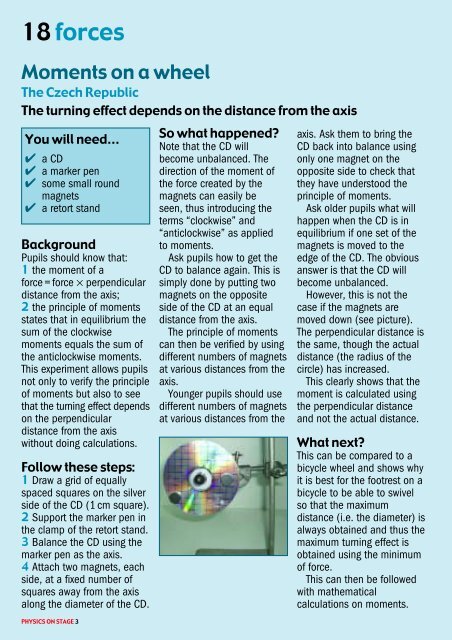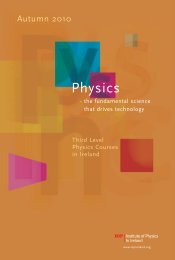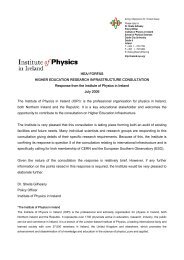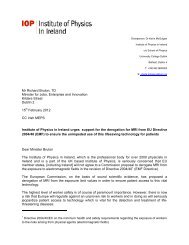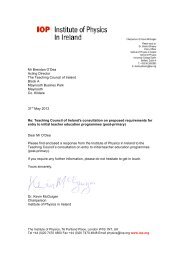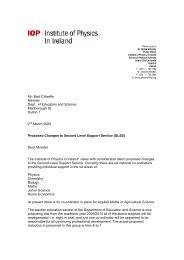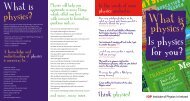PHY ICS - The Institute of Physics in Ireland
PHY ICS - The Institute of Physics in Ireland
PHY ICS - The Institute of Physics in Ireland
Create successful ePaper yourself
Turn your PDF publications into a flip-book with our unique Google optimized e-Paper software.
18 forces<br />
Moments on a wheel<br />
<strong>The</strong> Czech Republic<br />
<strong>The</strong> turn<strong>in</strong>g effect depends on the distance from the axis<br />
You will need...<br />
✔ a CD<br />
✔ a marker pen<br />
✔ some small round<br />
magnets<br />
✔ a retort stand<br />
Background<br />
Pupils should know that:<br />
1 the moment <strong>of</strong> a<br />
force = force × perpendicular<br />
distance from the axis;<br />
2 the pr<strong>in</strong>ciple <strong>of</strong> moments<br />
states that <strong>in</strong> equilibrium the<br />
sum <strong>of</strong> the clockwise<br />
moments equals the sum <strong>of</strong><br />
the anticlockwise moments.<br />
This experiment allows pupils<br />
not only to verify the pr<strong>in</strong>ciple<br />
<strong>of</strong> moments but also to see<br />
that the turn<strong>in</strong>g effect depends<br />
on the perpendicular<br />
distance from the axis<br />
without do<strong>in</strong>g calculations.<br />
Follow these steps:<br />
1 Draw a grid <strong>of</strong> equally<br />
spaced squares on the silver<br />
side <strong>of</strong> the CD (1 cm square).<br />
2 Support the marker pen <strong>in</strong><br />
the clamp <strong>of</strong> the retort stand.<br />
3 Balance the CD us<strong>in</strong>g the<br />
marker pen as the axis.<br />
4 Attach two magnets, each<br />
side, at a fixed number <strong>of</strong><br />
squares away from the axis<br />
along the diameter <strong>of</strong> the CD.<br />
<strong>PHY</strong>S<strong>ICS</strong> ON STAGE 3<br />
So what happened?<br />
Note that the CD will<br />
become unbalanced. <strong>The</strong><br />
direction <strong>of</strong> the moment <strong>of</strong><br />
the force created by the<br />
magnets can easily be<br />
seen, thus <strong>in</strong>troduc<strong>in</strong>g the<br />
terms “clockwise” and<br />
“anticlockwise” as applied<br />
to moments.<br />
Ask pupils how to get the<br />
CD to balance aga<strong>in</strong>. This is<br />
simply done by putt<strong>in</strong>g two<br />
magnets on the opposite<br />
side <strong>of</strong> the CD at an equal<br />
distance from the axis.<br />
<strong>The</strong> pr<strong>in</strong>ciple <strong>of</strong> moments<br />
can then be verified by us<strong>in</strong>g<br />
different numbers <strong>of</strong> magnets<br />
at various distances from the<br />
axis.<br />
Younger pupils should use<br />
different numbers <strong>of</strong> magnets<br />
at various distances from the<br />
axis. Ask them to br<strong>in</strong>g the<br />
CD back <strong>in</strong>to balance us<strong>in</strong>g<br />
only one magnet on the<br />
opposite side to check that<br />
they have understood the<br />
pr<strong>in</strong>ciple <strong>of</strong> moments.<br />
Ask older pupils what will<br />
happen when the CD is <strong>in</strong><br />
equilibrium if one set <strong>of</strong> the<br />
magnets is moved to the<br />
edge <strong>of</strong> the CD. <strong>The</strong> obvious<br />
answer is that the CD will<br />
become unbalanced.<br />
However, this is not the<br />
case if the magnets are<br />
moved down (see picture).<br />
<strong>The</strong> perpendicular distance is<br />
the same, though the actual<br />
distance (the radius <strong>of</strong> the<br />
circle) has <strong>in</strong>creased.<br />
This clearly shows that the<br />
moment is calculated us<strong>in</strong>g<br />
the perpendicular distance<br />
and not the actual distance.<br />
What next?<br />
This can be compared to a<br />
bicycle wheel and shows why<br />
it is best for the footrest on a<br />
bicycle to be able to swivel<br />
so that the maximum<br />
distance (i.e. the diameter) is<br />
always obta<strong>in</strong>ed and thus the<br />
maximum turn<strong>in</strong>g effect is<br />
obta<strong>in</strong>ed us<strong>in</strong>g the m<strong>in</strong>imum<br />
<strong>of</strong> force.<br />
This can then be followed<br />
with mathematical<br />
calculations on moments.


